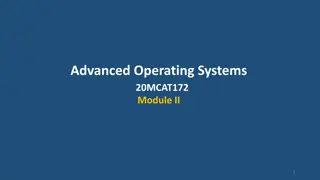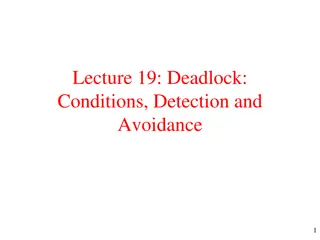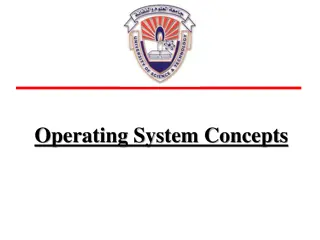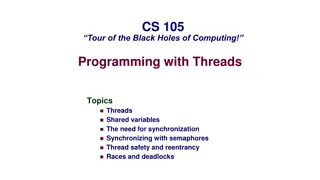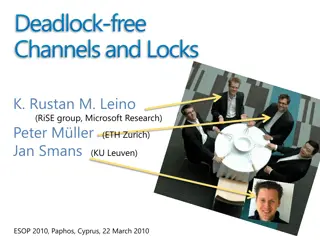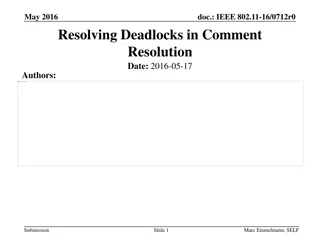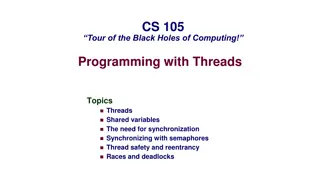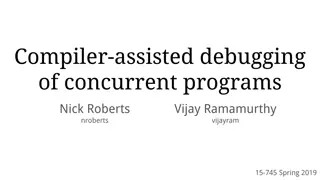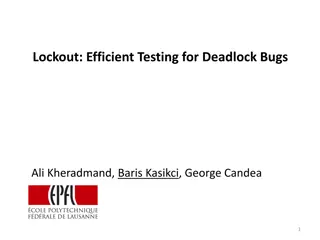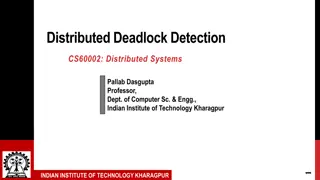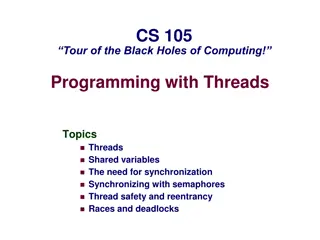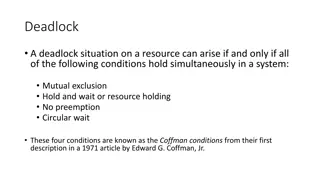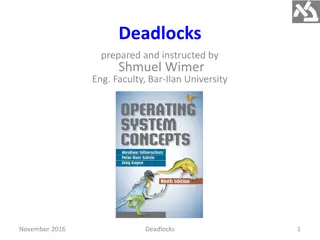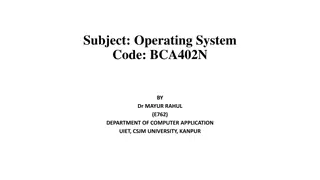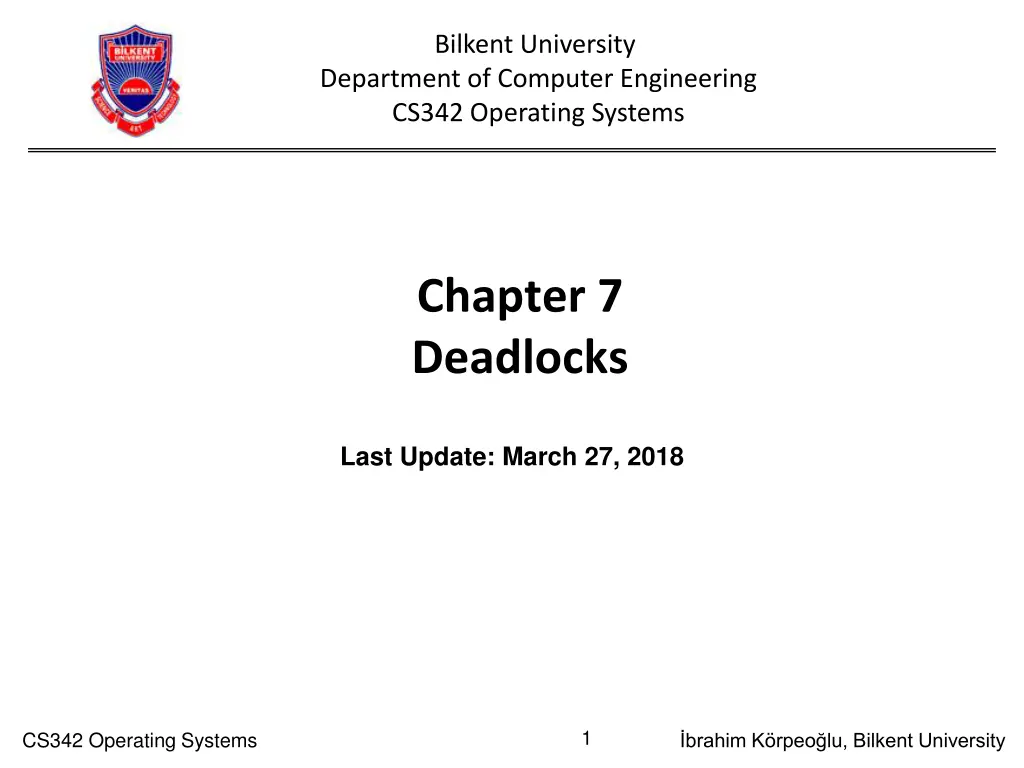
Understanding Deadlocks in Operating Systems
Explore the concept of deadlocks in operating systems, learn about deadlock prevention, avoidance, detection, and recovery methods. Understand the causes of deadlocks and how they can be resolved to ensure smooth system operation.
Download Presentation

Please find below an Image/Link to download the presentation.
The content on the website is provided AS IS for your information and personal use only. It may not be sold, licensed, or shared on other websites without obtaining consent from the author. If you encounter any issues during the download, it is possible that the publisher has removed the file from their server.
You are allowed to download the files provided on this website for personal or commercial use, subject to the condition that they are used lawfully. All files are the property of their respective owners.
The content on the website is provided AS IS for your information and personal use only. It may not be sold, licensed, or shared on other websites without obtaining consent from the author.
E N D
Presentation Transcript
Bilkent University Department of Computer Engineering CS342 Operating Systems Chapter 7 Deadlocks Last Update: March 27, 2018 1 CS342 Operating Systems brahim K rpeo lu, Bilkent University
Objectives and Outline Objectives To develop a description of deadlocks, which prevent sets of concurrent processes from completing their tasks Outline The Deadlock Problem System Model Deadlock Characterization Methods for Handling Deadlocks Deadlock Prevention Deadlock Avoidance Deadlock Detection Recovery from Deadlock To present a number of different methods for preventing or avoiding deadlocks in a computer system 2 CS342 Operating Systems brahim K rpeo lu, Bilkent University
The Deadlock Problem A set of blocked processes each holding a resource and waiting to acquire a resource held by another process in the set Example System has 2 disk drives P1 and P2 each hold one disk drive and each needs another one Example semaphores A and B, initialized to 1 P0 wait (A); wait (B); P1 wait(B) wait(A) 3 CS342 Operating Systems brahim K rpeo lu, Bilkent University
Bridge Crossing Example section1 section2 Traffic only in one direction Each section of a bridge can be viewed as a resource If a deadlock occurs, it can be resolved if one car backs up (preempt resources and rollback) Several cars may have to be backed up if a deadlock occurs Starvation is possible Note Most OSes do not prevent or deal with deadlocks 4 CS342 Operating Systems brahim K rpeo lu, Bilkent University
System Model Resource types R1, R2, . . ., Rm CPU cycles, memory space, I/O devices Each resource type Ri has Wi instances. Each process utilizes a resource as follows: request (may cause the process to wait) use release 5 CS342 Operating Systems brahim K rpeo lu, Bilkent University
Deadlock Characterization Deadlocks can arise if four conditions hold simultaneously Mutual exclusion: only one process at a time can use a resource Hold and wait: a process holding at least one resource is waiting to acquire additional resources held by other processes No preemption: a resource can be released only voluntarily by the process holding it, after that process has completed its task Circular wait: there exists a set {P0, P1, ,PN, P0} of waiting processes such that P0 is waiting for a resource that is held by P1, P1 is waiting for a resource that is held by P2, , Pn 1 is waiting for a resource that is held by Pn, and Pn is waiting for a resource that is held by P0. 6 CS342 Operating Systems brahim K rpeo lu, Bilkent University
Resource-Allocation Graph A set of vertices V and a set of edges E. V is partitioned into two types: P = {P1, P2, , Pn}, the set consisting of all the processes in the system R = {R1, R2, , Rm}, the set consisting of all resource types in the system request edge directed edge Pi Rj assignment edge directed edge Rj Pi 7 CS342 Operating Systems brahim K rpeo lu, Bilkent University
Resource-Allocation Graph (Cont.) Process Resource Type with 4 instances Pirequests instance of Rj Pi Rj Pi is holding an instance of Rj Pi Rj 8 CS342 Operating Systems brahim K rpeo lu, Bilkent University
Resource Allocation Graph With A Deadlock There is a cycle and Deadlock 9 CS342 Operating Systems brahim K rpeo lu, Bilkent University
Graph With A Cycle But No Deadlock There is a cycle but No Deadlock 10 CS342 Operating Systems brahim K rpeo lu, Bilkent University
Basic Facts If graph contains no cycles no deadlock If graph contains a cycle if only one instance per resource type, then deadlock Call it Single Instance System if multiple instances per resource type, possibility of deadlock Call it Multiple Instance System 11 CS342 Operating Systems brahim K rpeo lu, Bilkent University
Methods for Handling Deadlocks Ensure that the system will never enter a deadlock state Deadlock Prevention or Deadlock Avoidance methods Allow the system to enter a deadlock state and then recover Deadlock Detection needed Ignore the problem and pretend that deadlocks never occur in the system; Used by most operating systems, including UNIX OS does not bother with deadlocks that can occur in applications 12 CS342 Operating Systems brahim K rpeo lu, Bilkent University
Deadlock Prevention Basic Principle: Restrain the ways requests can be made Mutual Exclusion not required for sharable resources; must hold for nonsharable resources Example: spooling for printer Hold and Wait must guarantee that whenever a process requests a resource, it does not hold any other resources Require process to request and allocated all its resources at beginning Allow process to request resources only when it has none Low resource utilization; starvation possible 13 CS342 Operating Systems brahim K rpeo lu, Bilkent University
Deadlock Prevention (Cont.) No Preemption A process holding resources makes request: if request cannot be granted, release (preempt) the held resources, and try again later. Preempted resources are added to the list of resources for which the process is waiting Process will be restarted only when it can regain its old resources, as well as the new ones that it was requesting. Example: memory as a resource needed by a program Circular Wait impose a total ordering of all resource types, and require that each process requests resources in an increasing order 14 CS342 Operating Systems brahim K rpeo lu, Bilkent University
Deadlock Prevention (Cont.) All resources are ordered and assigned an integer number A process can request resources in increasing order of enumeration Resources R5 R1 R2 R3 R4 can only request and allocate in this order Example: Process 2 Request R1 Request R2 Request R3 Process 3 Request R3 Request R4 Process 1 Request R2 Request R4 15 CS342 Operating Systems brahim K rpeo lu, Bilkent University
Proof Consider the resources that are allocated at the moment. Consider the process that has the highest numbered allocated resource. That process will not block; will be able to continue and finish. Because: It can not make a request to a resource with a smaller number and get block. This will not happen. It can make a request to a resource with a larger number. That resource is not allocated yet (otherwise that would be the highest numbered allocated resource). Hence the process will get the resource immediately. In this way, that process will not block. Will be able to run and complete. Then, the same thing will be applicable to the process that is now holding the next highest numbered resource. That will be able to run and finish as well. All processes may run and finish sooner or later. 16 CS342 Operating Systems brahim K rpeo lu, Bilkent University
Deadlock Avoidance Basic Principle: Requires that the system has some additional a priori information available Simplest and most useful model requires that each process declare the maximum number of resources of each type that it may need to hold simultaneously. (maximum demand) The deadlock-avoidance algorithm dynamically examines the resource- allocation state to ensure that there can never be a circular-wait condition. Resource-allocation state is defined by the number of available and allocated resources, and the maximum demands of the processes 17 CS342 Operating Systems brahim K rpeo lu, Bilkent University
Safe state When a process requests an available resource, system must decide if immediate allocation leaves the system in a safe state A state is safe if the system can allocate resources to each process (up to its maximum) in some order and still avoid a deadlock. We are considering a worst-case situation here. Even in the worst case (processes request up their maximum at the moment), we don t have deadlock in a safe state. 18 CS342 Operating Systems brahim K rpeo lu, Bilkent University
Safe state More formally: A system state is safe if there exists a safe sequence of all processes (<P1, P2, , Pn>) such that for each Pi, the resources that Pi can still request can be satisfied by currently available resources + resources held by all processes earlier in the sequence (all Pj, with j < i) That is: If Pi resource needs are not immediately available, then Pi can wait until all Pj (j < i) have finished When Pj finished, Pi can obtain needed resources, execute, return allocated resources, and terminate When Pi terminates, Pi +1 can obtain its needed resources, and so on. 19 CS342 Operating Systems brahim K rpeo lu, Bilkent University
Basic Facts If a system is in safe state no deadlocks If a system is in unsafe state possibility of deadlock Avoidance ensure that a system will never enter an unsafe state. This is done by: Each time a request is made by a process for some resources: Check before allocating resources; if allocation would leave the system in an unsafe state, then do not allocate the resources; process is waited and resources are not allocated to that process. Otherwise resources can be allocated. 20 CS342 Operating Systems brahim K rpeo lu, Bilkent University
Safe, Unsafe , Deadlock State 21 CS342 Operating Systems brahim K rpeo lu, Bilkent University
Avoidance Algorithms Single instance of a resource type Use a resource-allocation graph Multiple instances of a resource type Use the banker s algorithm 22 CS342 Operating Systems brahim K rpeo lu, Bilkent University
Resource-Allocation Graph Scheme Claim edgePi Rj indicates that process Pimay request resource Rj; represented by a dashed line Claim edge is converted to a request edge when a process requests a resource Request edge is converted to an assignment edge when the resource is allocated to the process When a resource is released by a process, assignment edge is reconverted to a claim edge Resources must be claimed a priori in the system 23 CS342 Operating Systems brahim K rpeo lu, Bilkent University
Resource-Allocation Graph 24 CS342 Operating Systems brahim K rpeo lu, Bilkent University
Resource-Allocation Graph P2 requests R2; should we allocate? 25 CS342 Operating Systems brahim K rpeo lu, Bilkent University
Unsafe State In Resource-Allocation Graph 26 CS342 Operating Systems brahim K rpeo lu, Bilkent University
Resource-Allocation Graph Algorithm Suppose that process Pi requests a resource Rj The request can be granted only if converting the request edge to an assignment edge does not result in the formation of a cycle in the resource allocation graph. 27 CS342 Operating Systems brahim K rpeo lu, Bilkent University
Banker s Algorithm Multiple instances Each process must a priori claim maximum use System will know maximum demand of each process When a process requests a resource it may have to wait When a process gets all its resources, it must return them in a finite amount of time 28 CS342 Operating Systems brahim K rpeo lu, Bilkent University
Simple Example Assume a resource A (printer) has 5 instances. There are 2 processes: P1, P2 Max demand is: 5 5 Current Allocation is: 3 0 Need is: .? Available is: ? Is the current state safe? 29 CS342 Operating Systems brahim K rpeo lu, Bilkent University
Simple Example Assume P2 request 1 instance and it is granted. Is the new state safe? Current Allocation will be : 3 1 Need is: .. Available is: .. 30 CS342 Operating Systems brahim K rpeo lu, Bilkent University
Data Structures for the Banker s Algorithm Let n = number of processes, and m = number of resources types. Available: Vector of length m. If Available[j] == k, there are k instances of resource type Rjat the time deadlock avoidance algorithms is run. Max: n x m matrix. If Max[i,j] == k, then process Pimay request at most k instances of resource type Rj Allocation: n x m matrix. If Allocation[i,j] == k then Pi is currently allocated k instances of Rj Need: n x m matrix. If Need[i,j] = k, then Pi may need k more instances of Rj to complete its task Need[i,j] = Max[i,j] Allocation[i,j] 31 CS342 Operating Systems brahim K rpeo lu, Bilkent University
An example system state Available A B C 10 5 7 Initially Available == Existing Existing A B C 10 5 7 All resources in the system system state at some t (may change) Need = Max - Allocation Max A B C 7 5 3 Allocation A B C 0 1 0 Need A B C 7 4 3 Available A B C 3 3 2 P0 P0 P0 P1 3 2 2 P1 2 0 0 P1 1 2 2 P2 9 0 2 P2 3 0 2 P2 6 0 0 P3 2 2 2 P3 2 1 1 P3 0 1 1 P4 4 3 3 P4 0 0 2 P4 4 3 1 32 CS342 Operating Systems brahim K rpeo lu, Bilkent University
Notation Compare two vectors: X X is a matrix. A B C 0 1 0 Ex: compare V with Xi V P0 Xi is the ith row of the matrix: it is a vector. For example, X3 = [2 1 1] P1 2 0 0 P2 3 0 2 Xi P3 2 1 1 P4 0 0 2 V == Xi ? V <= Xi ? Xi <= V ? . V A B C 3 3 2 V is a vector; V = [3 3 2] Ex: Compare [3 3 2] with [2 2 1] [2 2 1] <= [3 3 2] 33 CS342 Operating Systems brahim K rpeo lu, Bilkent University
Safety Algorithm 1. Let Work and Finish be vectors of length m and n, respectively. Initialize: Work = Available (initialize Work temporary vector) Finish [i] = false for i= 0, 1, , n-1 (Work is a temporary vector initialized to the Available (i.e., free) resources at that time when the safety check is performed) Allocation A B C Need A B C 2. Find an i such that both: (a) Finish [i] = false (b) Needi Work If no such i exists, go to step 4 3. Work = Work + Allocationi Finish[i] = true go to step 2 P0 0 1 0 P0 7 4 3 Available [3 3 2] P1 2 0 0 P1 1 2 2 P2 3 0 2 P2 6 0 0 P3 2 1 1 P3 0 1 1 P4 0 0 2 P4 4 3 1 4. If Finish [i] == true for all i, then the system state is safe; o.w. unsafe. 34 CS342 Operating Systems brahim K rpeo lu, Bilkent University
Resource-Request Algorithm for Process Pi Requesti: request vector for process Pi. If Requesti[j] == k, then process Piwants k instances of resource type Rj Algorithm 1. If Requesti Needigo to step 2. Otherwise, raise error condition, since process has exceeded its maximum claim 2. If Requesti Available, go to step 3. Otherwise Pi must wait, since resources are not available 35 CS342 Operating Systems brahim K rpeo lu, Bilkent University
Resource-Request Algorithm for Process Pi 3. Pretend to allocate requested resources to Piby modifying the state as follows: Available = Available Requesti; Allocationi = Allocationi + Requesti; Needi= Needi Requesti; Run the Safety Check Algorithm: If safe the requested resources are allocated to Pi If unsafe The requested resources are not allocated to Pi. Pi must wait. The old resource-allocation state is restored. 36 CS342 Operating Systems brahim K rpeo lu, Bilkent University
Example of Banker s Algorithm 5 processes P0 through P4; 3 resource types: A, B, and C Existing Resources: A (10 instances), B (5 instances), and C (7 instances) Existing = [10, 5, 7] initially, Available = Existing. Assume, processes indicated their maximum demand as follows: Max A B C P0 7 5 3 P1 3 2 2 Initially, Allocation matrix will be all zeros. Need matrix will be equal to the Max matrix. P2 9 0 2 P3 2 2 2 P4 4 3 3 37 CS342 Operating Systems brahim K rpeo lu, Bilkent University
Example of Banker s Algorithm Assume later, at an arbitrary time t, we have the following system state: Need = Max - Allocation Existing = [10 5 7] Need A B C 7 4 3 Max A B C 7 5 3 Allocation A B C 0 1 0 Available A B C 3 3 2 P0 P0 P0 P1 1 2 2 P1 3 2 2 P1 2 0 0 P2 6 0 0 P2 9 0 2 P2 3 0 2 P3 0 1 1 P3 2 2 2 P3 2 1 1 P4 4 3 1 P4 4 3 3 P4 0 0 2 Is it a safe state? 38 CS342 Operating Systems brahim K rpeo lu, Bilkent University
Example of Banker s Algorithm Available A B C 3 3 2 Allocation A B C 0 1 0 Need A B C 7 4 3 P0 P0 P1 2 0 0 P1 1 2 2 P2 3 0 2 P2 6 0 0 P3 2 1 1 P3 0 1 1 P4 0 0 2 P4 4 3 1 Try to find a row in Needi that is <= Available. P1. run completion. Available becomes = [3 3 2] + [2 0 0] = [5 3 2] P3. run completion. Available becomes = [5 3 2] + [2 1 1] = [7 4 3] P4. run completion. Available becomes = [7 4 3] + [0 0 2] = [7 4 5] P2. run completion. Available becomes = [7 4 5] + [3 0 2] = [10 4 7] P0. run completion. Available becomes = [10 4 7] + [0 1 0] = [10 5 7] We found a sequence of execution: P1, P3, P4, P2, P0. State is safe 39 CS342 Operating Systems brahim K rpeo lu, Bilkent University
Example: P1 requests (1,0,2) At that time Available is [3 3 2] First check that Request Available (that is, (1,0,2) (3,3,2) true. Then check the new state for safety: Max A B C 7 5 3 Allocation A B C 0 1 0 Need A B C 7 4 3 Available A B C 2 3 0 P0 P0 P0 P1 3 2 2 P1 3 0 2 P1 0 2 0 P2 9 0 2 P2 3 0 2 P2 6 0 0 P3 2 2 2 P3 2 1 1 P3 0 1 1 P4 4 3 3 P4 0 0 2 P4 4 3 1 new state (we did not go to that state yet; we are just checking) 40 CS342 Operating Systems brahim K rpeo lu, Bilkent University
Example: P1 requests (1,0,2) Allocation A B C 0 1 0 Need A B C 7 4 3 Available A B C 2 3 0 P0 P0 P1 3 0 2 P1 0 2 0 P2 3 0 2 P2 6 0 0 P3 2 1 1 P3 0 1 1 P4 0 0 2 P4 4 3 1 new state Can we find a sequence? Run P1. Available becomes = [5 3 2] Run P3. Available becomes = [7 4 3] Run P4. Available becomes = [7 4 5] Run P0. Available becomes = [7 5 5] Run P2. Available becomes = [10 5 7] Sequence is: P1, P3, P4, P0, P2 Yes, New State is safe. We can grant the request. Allocate desired resources to process P1. 41 CS342 Operating Systems brahim K rpeo lu, Bilkent University
P4 requests (3,3,0)? Allocation A B C 0 1 0 Need A B C 7 4 3 Available A B C 2 3 0 P0 P0 P1 3 0 2 P1 0 2 0 P2 3 0 2 P2 6 0 0 P3 2 1 1 P3 0 1 1 P4 0 0 2 P4 4 3 1 Current state If this is current state, what happens if P4 requests (3 3 0)? There is no available resource to satisfy the request. P4 will be waited. 42 CS342 Operating Systems brahim K rpeo lu, Bilkent University
P0 requests (0,2,0)? Should we grant? Allocation A B C 0 1 0 Need A B C 7 4 3 Available A B C 2 3 0 P0 P0 P1 3 0 2 P1 0 2 0 P2 3 0 2 P2 6 0 0 P3 2 1 1 P3 0 1 1 P4 0 0 2 P4 4 3 1 Current state System is in this state. P0 makes a request: [0, 2, 0]. Should we grant. 43 CS342 Operating Systems brahim K rpeo lu, Bilkent University
P0 requests (0,2,0)? Should we grant? Assume we allocate 0,2,0 to P0. The new state will be as follows. Allocation A B C 0 3 0 Need A B C 7 2 3 Available A B C 2 1 0 P0 P0 P1 3 0 2 P1 0 2 0 P2 3 0 2 P2 6 0 0 P3 2 1 1 P3 0 1 1 P4 0 0 2 P4 4 3 1 New state Is it safe? No process has a row in Need matrix that is less than or equal to Available. Therefore, the new state would be UNSAFE. Hence we should not go to the new state. The request is not granted. P0 is waited. 44 CS342 Operating Systems brahim K rpeo lu, Bilkent University
Deadlock Detection Allow system to enter deadlock state Detection algorithm Recovery scheme 45 CS342 Operating Systems brahim K rpeo lu, Bilkent University
Single Instance of Each Resource Type Maintain wait-for graph Nodes are processes Pi Pj if Piis waiting for Pj Periodically invoke an algorithm that searches for a cycle in the graph. If there is a cycle, there exists a deadlock An algorithm to detect a cycle in a graph requires an order of n2 operations, where n is the number of vertices in the graph 46 CS342 Operating Systems brahim K rpeo lu, Bilkent University
Single Instance of Each Resource Type 47 CS342 Operating Systems brahim K rpeo lu, Bilkent University
Several Instances of Research Type Available: A vector of length m indicates the number of available resources of each type. Allocation: An n x m matrix defines the number of resources of each type currently allocated to each process. Request: An n x m matrix indicates the current request of each process. If Request [ij] = k, then process Pi is requesting k more instances of resource type Rj. System state is represented by this information 48 CS342 Operating Systems brahim K rpeo lu, Bilkent University
Detection Algorithm 1. Let Work and Finish be vectors of length m and n, respectively. Initialize: (a) Work = Available (b) For i= 1,2, , n, if Allocationi 0, then Finish[i] = false; otherwise, Finish[i] = true 2. Find an index i such that both: (a) Finish[i] == false (b) Requesti Work If no such i exists, go to step 4 49 CS342 Operating Systems brahim K rpeo lu, Bilkent University
Detection Algorithm (Cont.) 3. Work = Work + Allocationi Finish[i] = true go to step 2 4. If Finish[i] == false, for some i, 1 i n, then the system is in deadlock state. Moreover, if Finish[i] == false, then Pi is deadlocked 50 CS342 Operating Systems brahim K rpeo lu, Bilkent University

